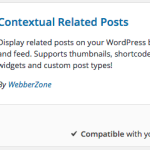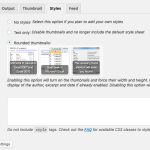Contextual Related Posts includes a shortcode the related posts list. If you’re not familiar with shortcodes, please read this article in the WordPress Codex.
[crp]
This shortcode lets you insert the contextually related posts anywhere in your post content. It takes two main optional attributes:
- limit: Maximum number of posts to return. The actual number displayed may be lower depending on the category / post exclusion settings
- heading: Set to 0 to disable the heading specified in Title of related posts: under Output options
In addition to these attributes, the shortcode can take all the options as attributes and these can override the plugin settings.
The following ones will affect the output of the related posts list:
- show_author: Display the author of the post. 1 or 0
- show_date: Display the published date of the post. 1 or 0
- show_excerpt: Display the excerpt. 1 or 0
- title_length: A numerical value to limit the length of the titles in the display
- offset: A numerical value to indicate the number of posts to displace or pass over
- post_types: Comma separated list of post types from which to select the related posts
- exclude_post_ids: Comma separated list of IDs to exclude
- thumb_width: Thumbnail width. Accepts a number
- thumb_height: Thumbnail height. Accepts a number
- post_thumb_op: Location of the post thumbnail. Values include
inline,after,text_onlyandthumbs_only - link_nofollow: Add nofollow attribute to links. 1 or 0
- link_new_window: Add _blank attribute to links. 1 or 0
- daily_range: A numerical value that sets the oldest date of the related posts
- ordering: Options are relevance, random and date
- same_post_type: Limit to same post type. 1 or 0
- same_author: Limit to same post author. 1 or 0
- include_cat_ids: Comma separated list of term_taxonomy_id – this can be both categories and custom taxonomies
- include_post_ids: Comma separated list of post IDs to always include
 Installing and Using Contextual Related Posts
Installing and Using Contextual Related Posts Followed Posts shortcode
Followed Posts shortcode Customising the output of Contextual Related Posts
Customising the output of Contextual Related Posts Contextual Related Posts Settings – Styles
Contextual Related Posts Settings – Styles